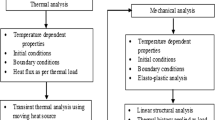Abstract
Effect of residual stresses on mixed mode stress intensity factor (SIF) of dissimilar welds (steel AISI 304 and aluminum AA1050) has been investigated numerically. Opposite surface cracks of various crack depth ratio [(a/t); “a” crack depth, “t” plate thickness] and crack aspect ratio [(a/c); “c” semi-major axis of the ellipse] were considered for different heat flux values. The geometry correction factor (Y) was determined with consideration of mode II and mode III fracture. It is noted that, at short crack depths, as the residual stress increases, SIF of steel region decreases and increases for aluminum region. When the crack depth ratio increases, SIF of both materials decreases due to relieving of residual stress at higher crack depths. Non-uniform crack opening was observed along the crack border, front, and rear side of the plate. A three-parameter relationship has been arrived to determine the structural integrity of dissimilar welded joint.















Similar content being viewed by others
Abbreviations
- a:
-
Crack length (mm)
- c:
-
Semi-major axis of the ellipse (mm)
- P,P0 :
-
Points along the crack front
- (a/t):
-
Crack depth ratio
- (a/c):
-
Crack aspect ratio
- P/P0 :
-
Location ratio
- Y:
-
Geometry correction factor
- σ:
-
Farfield stress (MPa)
- ν:
-
Poisson’s ratio
References
Anawa EM, Olabi AG (2008) Control of welding residual stress for dissimilar laser welded materials. J Mater Process Technol 204:22–33
Steuwer A, Peel MJ, Withers PJ (2006) Dissimilar friction stir welds in AA5083-AA6082: the effect of process parameters on residual stress. J Mater Sci Eng 441:187–196
Lee C-H, Chang K-H (2013) Influence of the residual stresses and distortions on the structural behaviour of girth-welded cylindrical steel members. J Constr Build Mater 41:766–776
Labeas G, Diamantakos I (2013) Laser beam welding residual stresses of cracked T-joints. J Theor Appl Fract Mech 63–64:69–76
Wang HT, Wang GZ, Xuan FZ, Liu CJ, Tu ST (2013) Local mechanical properties of a dissimilar metal welded joint in nuclear power systems. J Mater Sci Eng 568:108–117
Lee C-H, Chang K-H (2007) Numerical analysis of residual stresses in welds of similar or dissimilar steel weldments under superimposed tensile loads. J Comput Mater Sci 40:548–556
Lee C-H, Chang K-H (2012) Temperature fields and residual stress distributions in dissimilar steel butt welds between carbon and stainless steel. J Appl Therm Eng 45:33–41
Collini L, Giglio M, Garziera R (2012) Thermo mechanical stress analysis of dissimilar welded joints in pipe supports: structural assessment and design optimization. J Eng Fail Anal 26:31–49
Labeas G, Diamantakos I (2009) Numerical investigation of through crack behaviour under welding residual stress. J Eng Fract Mech 76:1691–1702
Wu XR (1984) The effect of welding residual stress on brittle fracture of plates with surface cracks. J Eng Fract Mech 19:427–439
Chang K-H, Lee C-H (2007) Residual stresses and fracture mechanics analysis of a crack in welds of high strength steels. Eng Fract Mech 74:980–994
Dong P, Song S, Zhang J (2014) Analysis of residual stress relief mechanisms in post-weld heat treatment. Int J Press Vessel Pip 122:6–14
Suresh Kumar S, Naren Balaji V, Prrithvi PM (2014) Influence of residual stress on stress intensity factor estimation of multiple cracks in dissimilar welded joint. Int J Proc Eng 86:234–241
Song T-K, Kim Y-B, Kim Y-J, Oh C-Y (2014) Prediction of welding residual stress profile in dissimilar metal nozzle butt weld of nuclear power plant. Procedia Mater Sci 3:784–789
Ogawa T, Itatani M, Saito T, Hayashi T, Narazaki C, Tsuchi K (2012) Fracture assessment for a dissimilar metal weld of low alloy steel and Ni-base alloy. Int J Press Vessel Pip 90-91:61–68
Author information
Authors and Affiliations
Corresponding author
Additional information
Recommended for publication by Commission X - Structural Performances of Welded Joints - Fracture Avoidance
Rights and permissions
About this article
Cite this article
S, S., V, N. & P.M, P. Numerical studies on mixed mode fracture behavior of dissimilar (AISI 304 and AA1050) welded joints with multiple cracks. Weld World 62, 565–579 (2018). https://doi.org/10.1007/s40194-018-0550-5
Received:
Accepted:
Published:
Issue Date:
DOI: https://doi.org/10.1007/s40194-018-0550-5




